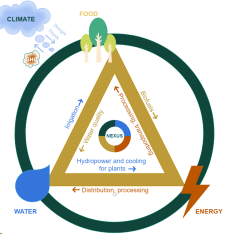
Event date:
Jan
26
2021
2:30 pm
Climate Informatics for the Water Energy Food Nexus: A System Dynamics Perspective on Dairy Farm Operations
Supervisor
Dr. Abubakr Muhammad
Dr. Talha Manzoor
Student
Muhammad Farooq
Venue
Zoom Meetings (Online)
Event
MS Thesis defense
Abstract
Climate patterns in the agricultural zones of the Indus basin are predicted to undergo undesirable changes in the hydrological cycle. These changes are a threat to the widespread agricultural activities and associated livelihoods of the underlying population. Livestock, an essential sector for human sustenance in the basin, is also a key source of greenhouse gas emissions thereby contributing towards climate change. However, it is also a victim of climate change, thus introducing feedbacks and uncertainties that are further accentuated by the Water-Energy-Food Nexus. Here, we model and simulate the farm-level dairy operations of a single dairy farm by introducing informatics-driven precision measurements of water, energy, food, and carbon emissions in a system dynamics framework. We analyze the simulated trajectories for energy, water, and waste fluxes under different interventive scenarios to identify actions that enhance productivity and minimize environmental impact. The model is constructed based on data gathered from two dairy farms located in rural Punjab, Pakistan. The farms have a livestock capacity of 300 and 134 animals respectively, with data related to water, energy, food, and climate gathered over a duration of two years. The model itself also helps in unravelling the complex interactions among water-energy-food flows along with their coupling to land-climate interactions in context of the dairy farm operations. Beyond the climate change adaptation measures extracted from this study, the system dynamics model that we constructed, can help develop economic tools that leverage the advantages of water/climate informatics driven data services and decisions under large variabilities to devise sound agricultural policy. We find that shifting to a more efficient irrigation technology not only reduces the environmental footprint through less pumping of groundwater but also results in consumption of less energy as compared to the business-as-usual scenario. If we increase irrigation efficiency by 35%, moving from flood irrigation, 367 million litres of irrigation water (68.38% of total) can be saved from 46.5 acre land area in one year. Furthermore, there are 912 litres of water, 0.65 kWh energy and 2.15 kg CO2-equivalent behind one litre of milk production. Moreover, we find that the slurry produced by 134 cows can generate 383.3 Nm3 biogas annually having 55% methane content which is enough to fulfil the energy requirements of the farm if diverted to a bio-gas generator. This not only saves operational costs by eliminating dependency on the grid but also prevents emissions that are generated by dumping the slurry in nearby landfills or dumps. Results show that for the considered farm, 3,354 ton fodder produced in a year from 46.5 acre land area assigned to 134 cows have 2,620 ton fodder surplus which is enough to accommodate 478 more dairy cows. Hence, managing crops in the cultivated land-area not only fulfills the fodder requirements for the farm animals but also results in production of excess fodder which can be sold to generate economic surplus. We also found that, besides milk, the main product of a dairy farm, fodder surplus produced, and electricity surplus produced add a revenue which have more than 50% value of milk revenue. The simulated results may be used to uncover structural changes in dairy-farm operations which improve the economic structure of the farm while remaining within the thresholds defined by Sustainable Development Goals (SDG) 3, 7 and 13 set by the United Nations.
Zoom meeting link:
https://zoom.us/j/99867203900?pwd=SXM0RmhTSnRmdGhqU2ppMFNNSTdiQT09
Meeting ID: 998 6720 3900
Passcode: 529765


